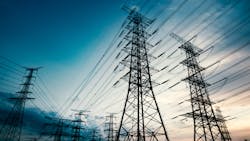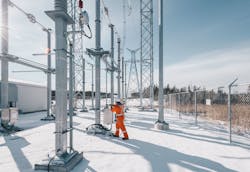Securing the Grid: Key Enablers for a Stronger Power System
The global power sector has made a dramatic transition toward sustainability and affordability of energy supply over the last decade. Positive advances include increasing use of variable renewables, more sustainable approaches to maintenance and equipment replacement, distributed generation, and electrification of other energy sectors such as transport and industries, as well as electrification of remote areas.
However, such rapid evolution poses a number of challenges for two crucial factors for power grid operators — resilience and reliability. These terms, however, are sometimes poorly defined.
"Resilience and reliability are functionally connected, although they mean very different things," explained Alexandre Oudalov, manager power systems of the future in market innovation at Hitachi ABB Power Grids. "Reliability is about reducing the probability of equipment failure or power interruptions, while resilience is about reducing the damage caused from outages and shortening their duration."
Wolf Mueller, senior vice president service at Hitachi ABB Power Grids added, "Reliability is actually subordinate to resilience, since improving reliability is one of the ways in which grid operators can improve overall resilience."
The resilience issue
In terms of electrical supply systems’ resilience — and the ability to mitigate, survive, and recover from high-impact threats and system failures — the challenges are manifold. These range from extreme weather, such as forest fires in California and the growing frequency of dangerous storms, to other unpredictable events, such as the loss of several power plants that led to power cuts for nearly one million people in the United Kingdom in 2019.
With a growing share of renewable generation connections to grids reliant on power electronic interfaces and fewer electro-mechanical couplings, system inertia and short circuit currents become scientifically time varying, which again challenges the resilience of modern power systems. Furthermore, human error is a big component. For example, during service operations, if there is a lack of systematic processes, it is possible for a single engineer to ground an important element causing a major short circuit, which can shut down a power system.
Along with the readiness for maintaining supply throughout and the recuperation from major disturbances that may be both extreme and prolonged, resilience can also refer to a company's abilities to continue developing and enhancing its operations during challenging periods.
The reliability issue
Reliability is challenged in a very specific manner in the power industry. As Wolf Mueller explained, "All utilities experience aging equipment that is facing new operating modes, energy flows, and loading patterns. It needs to cope with much more fluctuation and many more transitions through grid assets than ever before. This is combined with an aging workforce and talent pool in the market."
This is changing how customers invest in modernizing their installed base in order to improve reliability and resilience. One of the key considerations here is digital transformation — how can digital enablement help enhance resilience and reliability?
According to the Ernest Orlando Lawrence Berkeley National Laboratory, power outages cost the U.S. economy approximately US$79 billion a year. Clearly, ensuring the reliability of power grids is an important matter for generators, distributors, and customers, which is why most industry standards follow these key rules:
- Power generation and transmission capacity adequacy, that is, it must be able to meet peak demand for electricity. For example, 15% to 20% reserve.
- Power systems must have adequate flexibility at different levels (generation, T&D grids, demand side) to address variability and uncertainty in load and renewable generation resources.
- Power systems must be able to maintain steady frequency and voltage within an acceptable range.
In addition, grid operators must also maintain adequate levels of reliability as measured by the most used outage indices, SAIFI (the average number of sustained interruptions per consumer during the year) and SAIDI (the average duration of interruptions per consumers during the year).
Some countries have regulatory legislation to encourage power grid reliability and resilience. In the United States, the current legislative environment has not caught up with the regulatory reliability and resilience measures that have been implemented in the United Kingdom or Australia. For example, in the United Kingdom, the Electricity Act grid code regulates power grid operations and policies under the industry regulator, Office of Gas and Electricity Markets, while in Australia similar legislation exists to supervise the country's regulator, the Australian Energy Market Operator, working with state governments.
With the distinctive challenges posed by this evolving environment, it is no surprise that operators seek innovative technologies to improve resilience and reliability as they future-proof their operations.
What are the solutions?
Fortunately, a huge range of solutions exists to enhance resilience and reliability. Technical solutions include strong HVDC links, power quality solutions, remote data analysis services provided to substations, reliability-based maintenance solutions, rapid response rooms used to locate faults, 24x7 expert advice based anywhere in the world, as well as advances including augmented reality (AR) and drone maintenance.
For reliability-based maintenance solutions, the increasing amount of connected assets and use of artificial intelligence (AI) is enabling operators to better anticipate the risk of equipment failures by using the industrial internet of things (IIoT) to enable sensors that collect and analyze data from various units to significantly reduce their costs of downtime and maintenance.
To handle fluctuations in power flow and voltages, the overload management equipment must have an extended range, react fast to disturbances and apply remedial actions (sometimes in milliseconds), such as high voltage direct current (HVDC).
Expertise in partnership
HITACHI ABB Power Grids has recently responded to this increased need for reliability with the launch of RelCare — a reliability-based, state-of-the-art maintenance partnership solution for customers to optimize their substation asset management and system performance.
RelCare applies a risk matrix to a customer's assets and increases focus on executing the right maintenance actions to ensure proactive detection and avoidance of most impacting failures. It embeds safe maintenance policies, offers system reliability and financial modeling, planning optimization, and increased focus to take the most relevant maintenance decisions.
Through its dynamic monitoring, it enables proactive planning of maintenance actions and reduction of costly emergency repairs, while also preventing failures related to poorly executed maintenance by following digitalized step-by step execution procedures.
Moreover, RelCare contributes to greater sustainability, as key components will only be replaced when needed and power from sustainable sources can be better integrated. A more automated approach to maintenance will mean less traveling to site. The partnership provides an important step in preparing electrical infrastructure at a time when countries all over the globe are increasingly looking to reduce their dependence on fossil fuels.
According to Wolf Mueller, sustainability through lifetime extension has a big impact. "Only heavily polluting transportation, power, or industrial assets, with high fuel consumption and high emissions have a negative sustainability balance if life is extended. Extending the lifetime of T&D assets generally has a positive impact unless they are highly inefficient and loss making, when upgrades and retrofits are the next best option. It is a key pillar of any service sustainability rationale to repair and maintain prior to ripping out, replacing, and disposing."
The future
Wolf Mueller said, "In a demanding world of power infrastructure, it is critical for equipment to operate at the highest level possible to prevent power failure. Power cuts are highly critical in terms of lost revenue and socio-economic impact, considering the importance of power for safe transportation, reliable health care, and other critical segments.
"RelCare is a game-changing new approach to substation maintenance that enables O&M and asset managers to optimize maintenance costs, increase maintenance safety, and, most importantly, increase system reliability. Hitachi ABB Power Grids is committed to working with our customers, from utilities to data centers, to improve resilience and reliability operations throughout the entire value chain in order to build a stronger, smarter, and greener grid for the society of the future."





